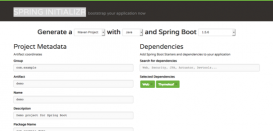通过注解注入bean
背景
我们谈到spring的时候一定会提到ioc容器、di依赖注入,spring通过将一个个类标注为bean的方法注入到ioc容器中,达到了控制反转的效果。那么我们刚开始接触bean的时候,一定是使用xml文件,一个一个的注入,就例如下面这样。
|
1
|
<bean id="bean" class="beandemo.bean" /> |
我们的项目一般很大的话,就需要成千上百个bean去使用,这样写起来就很繁琐。那么spring就帮我们实现了一种通过注解来实现注入的方法。只需要在你需要注入的类前面加上相应的注解,spring就会帮助我们扫描到他们去实现注入。
xml扫描包的方式
|
1
|
<context:component-scan base-package="com.company.beandemo"/> |
通过注解注入的一般形式
一般情况下,注入bean有一个最直白,最易懂的方式去实现注入,下面废话先不多说,先贴代码。
bean类
|
1
2
|
public class mybean{} |
configuration类
|
1
2
3
4
5
6
7
8
9
|
//创建一个class配置文件 @configuration public class myconfiguration{ //将一个bean交由spring进行管理@beanpublic mybean mybean(){ return new mybean();} } |
test类
与xml有一点不同,这里在test中,实例化的不再是classpathxmlapplicationcontext,而是获取的annotationconfigapplicationcontext实例。
|
1
2
3
|
applicationcontext context = new annotationconfigapplicationcontext(myconfiguration.class);mybean mybean = cotext.getbean("mybean",mybean.class);system.out.println("mybean = " + mybean); |
上面的代码中mybean也就是我们需要spring去管理的一个bean,他只是一个简单的类。而myconfiguration中,我们首先用@configuration注解去标记了该类,这样标明该类是一个spring的一个配置类,在加载配置的时候会去加载他。
在myconfiguration中我们可以看到有一个方法返回的是一个mybean的实例,并且该方法上标注着@bean的注解,标明这是一个注入bean的方法,会将下面的返回的bean注入ioc。
通过构造方法注入bean
我们在生成一个bean实例的时候,可以使用bean的构造方法将bean实现注入。直接看代码
bean类
|
1
2
3
4
5
6
7
8
9
10
11
12
13
14
15
16
17
|
@componentpublic class mybeanconstructor {private anotherbean anotherbeanconstructor;@autowiredpublic mybeanconstructor(anotherbean anotherbeanconstructor){ this.anotherbeanconstructor = anotherbeanconstructor;}@overridepublic string tostring() {return "mybean{" +"anotherbeanconstructor=" + anotherbeanconstructor +'}';}} |
anotherbean类
|
1
2
3
|
@component(value="bean的id,默认为类名小驼峰")public class anotherbean {} |
configuration类
|
1
2
3
4
|
@configuration@componentscan("com.company.annotationbean")public class myconfiguration{} |
这里我们可以发现,和一般方式注入的代码不一样了,我们来看看新的注解都是什么意思:
@autowired
简单粗暴,直接翻译过来的意思就是自动装配:wrench:,还不理解为什么叫自动装配:wrench:?看了下一个注解的解释你就知道了。若是在这里注入的时候指定一个bean的id就要使用@qualifier注解
@component(默认单例模式)
什么??这翻译过来是零件,怎么感觉像是修汽车??是的,spring管理bean的方法就是修汽车的方式。我们在需要将一个类变成一个bean被spring可以注入的时候加上注解零件@conmonent,那么我们就可以在加载bean的时候把他像零件一样装配:wrench:到这个ioc汽车上了
在这里我们还有几个其他的注解也可以实现这个功能,也就是细化的@component:
-
@controller 标注在controller层
- @service 标注在service层
- @repository 标注在dao层
- @componentscan("")
还是翻译,零件扫描,我们去看看括号里的“零件仓库”里面,哪些“零件”(类)需要被装载,spring就会去扫描这个包,将里面所有标注了@component的类进行注入。
这里的通过构造方法进行注入就很好理解了,我们在装配mybean这个零件的时候,突然发现他必须在anotherbean的基础上才能安装到ioc里面,那么我们就在每次装配mybean的时候自动装配:wrench:一个anotherbean进去。举个:chestnut:吧:
还是以汽车为例,我们在踩油门出发之前,是不是必须发车??这里的autowired的内容就像发车,你不发车,这个油门你踩断都没有用,他都不会走。
通过set方法注入bean
我们可以在一个属性的set方法中去将bean实现注入,看代码吧
mybean类
|
1
2
3
4
5
6
7
8
9
10
11
12
13
14
15
16
17
|
@componentpublic class mybeanset {private anotherbean anotherbeanset;@autowiredpublic void setanotherbeanset(anotherbean anotherbeanset) {this.anotherbeanset = anotherbeanset;}@overridepublic string tostring() {return "mybeanset{" +"anotherbeanset=" + anotherbeanset +'}';}} |
configuration类 和 test类
同上一个,就不贴了
这里我们发现在setter方法上我们有一个@autowired,与上面不同的是,我们不会在实例化该类时就自动装配:wrench:这个对象,而是在显式调用setter的时候去装配。
通过属性去注入bean
我们前面两种注入的方式诸如时间不同,并且代码较多,若是通过属性,即就是
|
1
2
3
4
5
6
7
8
9
10
11
12
13
|
@componentpublic class mybeanproperty {@autowiredprivate anotherbean anotherbeanproperty;@overridepublic string tostring() {return "mybeanproperty{" +"anotherbeanproperty=" + anotherbeanproperty +'}';}} |
这里我们可以看到我们这个类中需要使用anotherbean这个实例对象,我们可以通过@autowired去自动装配它。
对于有些小伙伴问私有属性,spring怎么去加载它到ioc的?推荐去看看反射
通过list注入bean
mybeanlist类
|
1
2
3
4
5
6
7
8
9
10
11
12
13
14
|
@componentpublic class mybeanlist {private list<string> stringlist;@autowiredpublic void setstringlist(list<string> stringlist) {this.stringlist = stringlist;}public list<string> getstringlist() {return stringlist;}} |
myconfiguration类
|
1
2
3
4
5
6
7
8
9
10
11
12
|
@configuration@componentscan("annobean.annotationbean")public class myconfiguration { @bean public list<string> stringlist(){ list<string> stringlist = new arraylist<string>(); stringlist.add("list-1"); stringlist.add("list-2"); return stringlist; }} |
这里我们将mybeanlist进行了注入,对list中的元素会逐一注入。下面介绍另一种方式注入list
myconfiguration类
|
1
2
3
4
5
6
7
8
9
10
11
12
|
@bean//通过该注解设定bean注入的优先级,不一定连续数字@order(34)public string string1(){ return "string-1";}@bean@order(14)public string string2(){ return "string-2";} |
注入与list中泛型一样的类型,会自动去匹配类型,及时这里没有任何list的感觉,只是string的类型,但他会去通过list的bean的方式去注入。
第二种方式的优先级高于第一种,当两个都存在的时候,若要强制去使用第一种方式,则要去指定bean的id即可
通过map去注入bean
|
1
2
3
4
5
6
7
8
9
10
11
12
13
14
|
@componentpublic class mybeanmap {private map<string,integer> integermap;public map<string, integer> getintegermap() { return integermap;}@autowiredpublic void setintegermap(map<string, integer> integermap) { this.integermap = integermap;}} |
|
1
2
3
4
5
6
7
8
9
10
11
12
13
14
15
16
17
|
@beanpublic map<string,integer> integermap(){ map<string,integer> integermap = new hashmap<string, integer>(); integermap.put("map-1",1); integermap.put("map-2",2); return integermap;}@beanpublic integer integer1(){ return 1;}@beanpublic integer integer2(){ return 2;} |
同样这里也具有两种方式去注入map类型bean,且第二种的优先值高于第一种
以上就是bean通过注解注入的几种方式,大家可以对比着xml注入的方式去看。
总结
以上就是这篇文章的全部内容了,希望本文的内容对大家的学习或者工作具有一定的参考学习价值,谢谢大家对服务器之家的支持。
原文链接:https://juejin.im/post/5ca81a536fb9a05e6538aa39
















